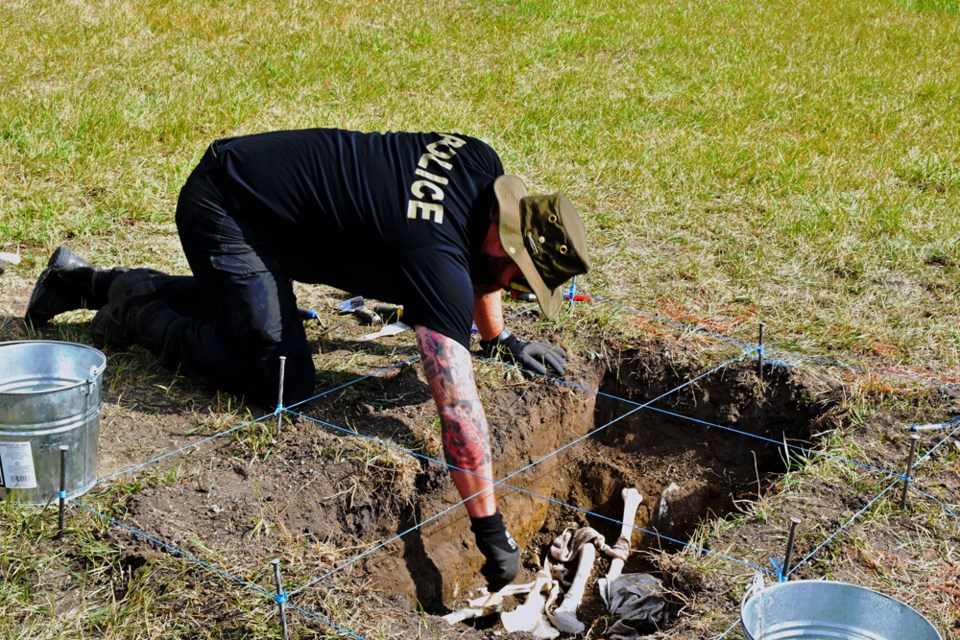WARMAN — Scenes that you usually see on television crime drama series were re-enacted on Thursday, Sept. 15, at the Warman Fire Department facility by participants of the forensic anthropology course offered by the RCMP.
Police officers from British Columbia in the west to Newfoundland in the east and up in the northern territories to as far down south in neighbouring USA, joined in the course conducted by University of Saskatchewan archaeology and anthropology professor emeritus Dr. Ernie Walker.
Walker has been helping law enforcement agencies in the field of forensic identification of human remains, especially in criminal investigations where bones or items related to an ongoing case are unearthed.
He said the course is to help law enforcement personnel locate, recover and identify human remains that included classroom sessions and an outdoor setting to experience and apply what they have learned.
“This part of the course is called forensic identification, forensic anthropology. We’ve been teaching this class now for decades. This is the first time we’ve been working on a property owned by the City of Warman, specifically the Warman Fire Department,” said Walker.
“Yesterday was surface scatters as if human remains were deposited and then scattered around by animals. So, they had to delineate a crime scene, and perimeter and search that. This does involve using prospecting equipment, metal detection for that.”
Thursday’s exercise was a simulation of clandestine grave sites where participants were learning how to establish the location and process the scene, doing the excavation carefully and scientifically just like it is done in an actual investigation.
“The purpose of all of this is to have members of forensic identification services in the RCMP and municipal forces, who normally process [these types of] scenes, to gain experience on these kinds of surface scatters and these kinds of clandestine interments,” said Walker.
“We’ve had sessions on burnt remains. So, they have been now experienced to identify fragments. Knowing what they’re recovering, they have anatomy as part of this course.”
Sgt. Donna Zawislak, who is under the RCMP Saskatchewan Major Crime/Historical Case Unit, said the course was organized to allow investigators to learn and experience these types of crime scenes.
“We can read about it. We can watch it. There are a lot of videos out there that you can access but there’s nothing like going out there and doing the work ad the process. What better way to do it than in scenarios versus having to do it in real life,” Zawislak said.
She added that although the latest technology like ground penetrating radars, drones and metal detectors are used in locating pieces of evidence, bodies or potential grave sites, law enforcement agencies still have some help from K-9 units.
“Yes, there’s still the use of cadaver dogs. It is one of the investigational techniques that we still use. Like in Saskatchewan, we have a couple of dogs that we use. Again, it is dependent on the circumstances. It is not every time we need a dog. If we can be very thorough where we can take all of our equipment and have a dog. We are going to use all of our resources,” Zawislak told SASKTODAY.ca.
“In general, we usually have a starting point when someone comes to us saying they found what they think is a grave. They will take us out there. It might be a piece of information from the person who was responsible for the crime where they would say, ‘I did this and this is where I put the person.’” Sometimes, we will use the GPR and do some probing.”
She added that investigators and their team would not just start digging in a potential site where the body of the person was buried, instead, they would use the GPR to start probing the area to determine what is underneath.
“We also research to corroborate the information because it is a lot of time and resources are needed in digging a hole. Sometimes people will find remains when they are digging in the basement of their houses or buildings. Sometimes, when people are hunting they will find bones and they will call the police. That helps us a lot because we know where to go.”
Christian Rouleau, who is a member of the Quebec Provincial Police assigned in Montreal, said he grabbed the opportunity to join the course to learn more about the forensic investigation that may be someday useful in his work.
“I was pleased I came here and it is something that we do a lot in our line of work. It is going to help me a lot when I come back home. I learned how to differentiate an animal bone from human bones,” said Rouleau.




